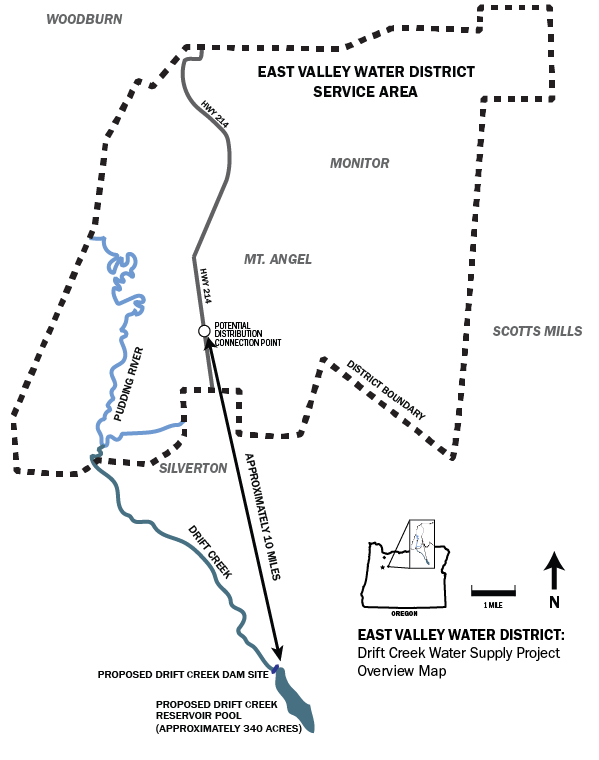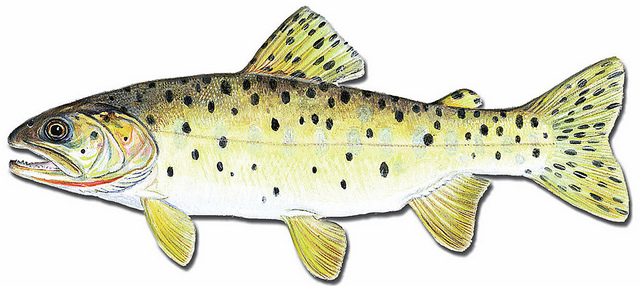Overview
The Drift Creek Water Supply Development Project aims to develop a supplemental water supply source for the East Valley Water District to provide irrigation water to its members; satisfying current and future demands.
To ensure the mission of the project is achieved, it must meet the following requirements:
• Be an adequate and safe long-term water supply
• Be an acceptable source of water for health, water quality and environmental impacts
• Be a reliable and resilient source of water
• Be an affordable source of water now and in the future
• Be a permitable source of water, avoiding environmental impacts when possible, and minimizing and mitigating impacts through careful planning and design.
Why Drift Creek?
East Valley Water District considered several water supply strategies and over 75 sites before choosing Drift Creek as the site of their water supply development project. Drift Creek was chosen because studies show it to be an adequate, acceptable, reliable, affordable, and permitable solution.
Substantial hydrologic studies have been done to analyze the reliability and resiliency of the water; including studying the availability of water during low water periods and impacts of high water periods. The Drift Creek location fits the criteria for providing a sustainable water source now and in the future.
Geologic studies have been done to determine if there are any seismic or fault impacts that would cause safety or security concerns. Geotechnical observations at the site and explorations below the surface of the land did not show evidence of past fault-related ground rupture beneath the proposed reservoir footprint. Potential for fault-line ruptures is low.
Drift Creek Water Supply Project Details
The information contained below are the most current details available. This section will be updated as the project progresses. If you have any questions, please use the 'contact us' form on the right-hand side of the page.
The current proposed location of the Project is on Drift Creek near the junction of Victor Point Road and Fox Road. This is approximately six miles southeast of Silverton in Marion County. This facility would be the cornerstone of a new surface water supply system for the District. Stored winter water would be released during the summertime months and conveyed downstream to the District's members. At this time, East Valley Water District is still determining the method for delivering water from the reservoir to the membership.
The reservoir will be created by the construction of an earthen dam approximately 70ft high. The reservoir will store approximately 12,000 acre feet of water. The actual volume of water that could be stored in the reservoir will vary year-to-year based on flow conditions and requirements.
More details will be posted as they become available.
Safety and Environmental Considerations
Through several engineering and environmental studies, the Drift Creek site has proved to be the most viable. Additional detailed studies are planned to ensure the site is safe and has low environmental impact. The Project will also have to comply with stringent environmental and safety standards set by federal, state and local governments through the permitting process.
Several geotechnical analyses have been done to identify if there are any geological or seismic conditions that would cause the Project to be unsafe. 2005 and 2009 geotechncial observations at the site and subsurface explorations did not disclose evidence of fault-related disturbance or ground rupture beneath the proposed dam footprint. The potential for such disturbances was judged to be low. More studies are planned to ensure the site is geotechnically feasible.
The Project must comply to strict safety standards set at the federal and state levels under the Dam Safety Program. For more information on the standards, please download this booklet from Oregon Water Resources Department.
The Project must also avoid impacts to the environment. Drift Creek and its tributaries provide spawning, holding, and rearing habitats for non-native coho salmon and resident cutthroat trout. The coho salmon are considered non-native as historically they were not present prior to the laddering of Willamette Falls Dam. Although Drift Creek and its tributaries provide some non-native salmonid habitat, the capacity to support spawning, rearing, and holding is limited and has been determined to be low quality habitat when compared to reference values used by the Oregon Department of Fish and Wildlife to rate North Cascade Streams. With that said, the Drift Creek Water Supply Development Project will have to enhance fish habitat on lower Drift Creek and the Pudding River, improve water quality in Drift Creek, and meet minimum instream flow requirements to support habitat conditions.
The permitting process for the project requires significant studies to understand the impacts to water quality, the environment, cultural resources, and several other safety and environmental standards. As more information becomes available, it will be posted on this site.
Cutthroat trout are resident fish and spend their entire life cycle in freshwater. Cutthroat trout commonly live in lakes and reservoirs.
Alternatives Considered
East Valley Water District initiated studies on their future water supply over two decades ago. The District has evaluated several alternate means for developing a sustainable and safe water supply for their membership including alternate groundwater supplies, reclaimed water, importation of contracted water and other sites for a surface water storage facility. Click here for information on Alternatives Analysis.
Groundwater
Since 1999, Oregon Water Resources Department has been monitoring well measurements in this area. East Valley Water District lies within two Groundwater Limited Areas [Mt. Angel and Gladtidings] that are protected by Oregon Water Resources Department.
Groundwater Recharge was deemed infeasible for this project because the amount of irrigated land with water needs is lies within two Groundwater Limited Areas. There is not any data that assures that an aquifer storage recovery project would be viable. For more information on groundwater recharge, please read this blog post.
Reclaimed Water
Reclaimed water or recycled water, is former wastewater (sewage) that is treated to remove solids and certain impurities. The District worked with the City of Salem to determine if reclaimed water could be a viable alternative for a water supply. However, the cost of treating the water to state standards and the piping infrastructure needed proved to be too costly and infeasible. In addition, food processors were concerned with public health using reclaimed water to irrigate food products.
Importation of Contracted Water
In the past, the U.S. Bureau of Reclamation was able to provide water service contracts on the Willamette Basin Project. However, in 1999 service contracts were suspended pending completion of Endangered Species Act consultation. In July of 2008, National Marine Fisheries Service and the U.S. Fish and Wildlife Service issued biological opinions on the Willamette Basin Project to ensure the operation of Willamette projects, reservoirs, hatcheries, dams and riverbanks would not reduce the likelihood of survival and recovery of Endangered Species [four listed fish.] As a result of the biological opinion, no new contracts will be issued beyond what is currently existing. Due to the suspension of issuing long-term contracts, this is not a viable option.
Mallorie's Dairy Site
The Mallorie's Dairy site is located near Silverton at the intersection of Hazelgreen Road and Brush Creek Road. The site is flanked by Silver Creek to the south and Pudding River to the west. The site is currently for sale. In order to store the neccesary water needed by the District, approximately 20 million cubic yards of material would need to be excavated from the site. 70,000 cubic yards of that material could be used on site to create a 10ft berm along the sides of the property to contain the reservoir. The excavation would result in a reservoir that is 4,000 ft x 2,000 ft in area, and approximately 80 ft deep. To protect the groundwater supply, 10 million square feet of material would be required to line the base of the reservoir. While this option minimizes the need to purchase different land parcels and is near to the District's service area, this option is not feasible due to the environmental considerations and financial cost of constructing and maintaining the site. For more information, including technical details, on this investigation please click here.
Other Storage Facility Locations
East Valley Water District has considered over 75 sites over two decades. The three most viable sites considered were the Del Air Site, the Rock Creek Site and the Drift Creek site.
The Del Air site was deemed infeasible after extensive geotechnical studies were done and showed the 1993 Mt. Angel earthquake [5.7 on the Richter Scale] showed the Mt. Angel fault line in the project area was a much greater risk to the safety and security of the project than anticipated.
The Rock Creek Site was deemed infeasible because over two-thirds of the inundated area was designated as wetlands--the environmental impact of this was too great to move forward with the project.
The Drift Creek site was chosen due to economic, environmental and seismic reasons. The District continues to perform studies to ensure this is the most viable strategy and location to provide the membership with a safe, sustainable and economical water supply now and in the future.
Spring 2016 Update
Project Updates
East Valley Water District and its team of consultants have made significant progress in early 2016 on the Drift Creek Water Supply Project. As a District we have completed the following work:
Wetland Delineation Completed and Submitted to Department of State Lands (DSL): The consultant team developed a map and report of existing wetlands in the proposed reservoir footprint. That report was submitted to DSL in early 2016. The report will be reviewed by DSL and the findings will be an important input to the Environmental Permitting Package submitted this year.
Fish and Wildlife Studies: The District has invested heavily in performing thorough fish and wildlife studies both within and downstream of the proposed reservoir footprint. Biologists spent much of the summer walking along Drift Creek to understand the current conditions of fish habitat. Wildlife biologists have also worked with the Oregon Department of Fish and Wildlife to understand elk habitat. This work is informing further Elk Studies in 2016. A bulk of these studies are complete; and the consultant team is currently drafting the Biological Assessment to be submitted in the Environmental Permitting Package.
Phase I of Cultural Resources Studies are complete: The consultant team performed extensive pedestrian studies of the reservoir footprint in spring and summer 2015. Archaeologists walked the entire proposed reservoir footprint to identify cultural resources or historic artifacts in the area. If items were found, they were left on the site but noted in a report. Phase II studies will likely be performed in summer 2016. These investigations involve shovel test where archaeologists will excavate small areas where there is a high possibility of cultural resources. That soil will be sifted through a mesh screen to determine the presence of artifacts. [all ground will be restored to its original condition.] This information will be sent to the Oregon State Historic Preservation Office as a part of the Environmental Permitting process.
Water Distribution System Design is in Progress: In February 2016, the Board of Directors voted to initiate the design process for the water distribution system that will take water from the project to the District. The Board considered two alternatives: conveying the water instream to a pump station on the Pudding River; and putting the water in buried pipe from the reservoir site to a distribution point in the District. Both alternatives featured environmental benefits; however conveying the water to the Pudding River would cause impacts to endangered species that exist in the Pudding River (and not on Drift Creek.) Conveying the water in-stream would also cause some loss of water due to seepage. The piping alternative would result in a pressurized system that would eliminate the need for pumping and eliminate seepage loss. Thus, the Board voted to move forward with the piping alternative for the purpose of performing the Biological Assessment and permitting documentation. In the next coming months, the District and their consultants will be performing a detailed alternative analysis of these two methods including further engineering, environmental and economic analysis. During this time, an additional alternative may be identified.
Water Right Case is Moving Forward: The District received notice from the Oregon Department of Justice in early 2016 that the water right case will move forward. After initial stalling by the state, the District has asked that the case continue to move forward. A schedule has not yet been confirmed, but it is likely this process will take approximately two years. The District and Oregon Water Resources Department will defend the Preliminary Final Order issued in July 2014 against Protestants. This is a substantial undertaking for the District, and we will provide more updates and details as they become available.


